10 Essential Insights for Effective POS Data Analysis

10 Essential Insights for Effective POS Data Analysis
Overview
The article "10 Essential Insights for Effective POS Data Analysis" primarily focuses on key strategies and tools that enhance the analysis of point-of-sale (POS) data for retailers. It highlights the features of diverse datasets and advanced analytical tools, illustrating their advantages in uncovering valuable insights into consumer behavior and operational efficiencies.
By leveraging these resources, businesses can realize significant benefits, such as driving sales growth and improving customer satisfaction.
How can your organization utilize these insights to enhance its operations? This article provides actionable strategies that can be implemented to gain a competitive edge in the retail market.
Introduction
In an increasingly data-driven retail landscape, the ability to analyze Point of Sale (POS) data effectively has become a game changer for businesses aiming to enhance their operational efficiency and customer engagement. By tapping into diverse datasets and advanced analytics, retailers can uncover valuable insights that inform strategic decisions, optimize inventory, and boost sales.
However, with the sheer volume of data available, how can businesses ensure they are leveraging this information to its fullest potential?
This article explores essential insights and best practices for effective POS data analysis, offering retailers the tools they need to navigate the complexities of modern retail and stay ahead of the competition.
Initial Data Offering: Access Diverse Datasets for Retail Insights
The Initial Data Offering (IDO) serves as a crucial asset for merchants seeking to enhance their POS data analysis capabilities. By granting access to a variety of datasets—including alternative data and ESG data—IDO empowers businesses to uncover insights into consumer behavior, market trends, and operational efficiencies. With the aid of SavvyIQ's AI-powered Recursive Data Engine, businesses can harness these datasets to identify patterns, optimize inventory, and customize marketing strategies. This ultimately drives sales growth and enhances customer satisfaction.
Statistics reveal that businesses utilizing advanced POS analytics achieve inventory turnover rates that are 35% faster than those relying on traditional methods. This statistic underscores the efficiency that data-informed decision-making can bring to operations. Furthermore, a study by McKinsey indicates that retailers leveraging POS data analysis can experience a 30% increase in revenue growth, emphasizing the transformative potential of integrating alternative insights into retail strategies.
Industry leaders consistently highlight the vital role that alternative information plays in shaping retail insights. John Sculley notably remarked, 'No significant marketing choices have ever been made on qualitative information,' which underscores the necessity of quantitative insights for strategic planning. As the alternative information market is projected to reach USD 135.72 billion by 2030, its influence on retail analytics is expected to grow, enabling businesses to maintain competitiveness in a dynamic environment.
By utilizing IDO's diverse datasets for POS data analysis, retailers can significantly enhance their analytical capabilities, resulting in meaningful outcomes in their operations. How might your business leverage these insights to improve decision-making and drive growth? The potential for improved strategies and operational efficiencies is vast, and the time to act is now.
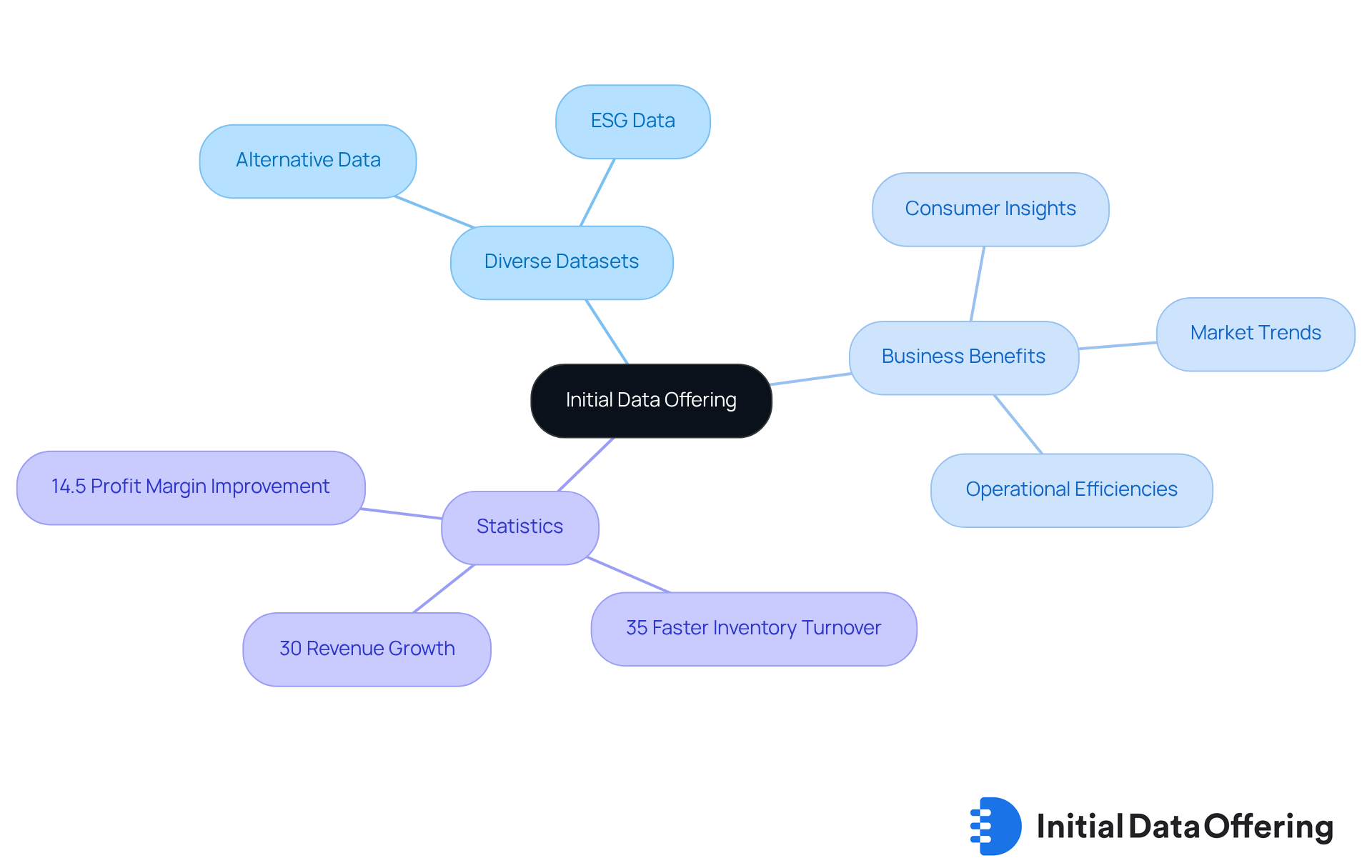
BigCommerce: Comprehensive Glossary for POS Data Analysis
BigCommerce offers a comprehensive glossary that serves as a valuable resource for individuals involved in pos data analysis. Understanding key terms such as:
- Conversion rate
- Average order value
- Customer lifetime value
is crucial for accurate interpretation of data. This knowledge empowers sellers to make informed decisions based on their pos data analysis, ultimately ensuring that their strategies align with current market conditions.
How can mastering these terms enhance your analytical capabilities? By familiarizing yourself with this glossary, you position yourself to leverage data effectively, leading to improved business outcomes.
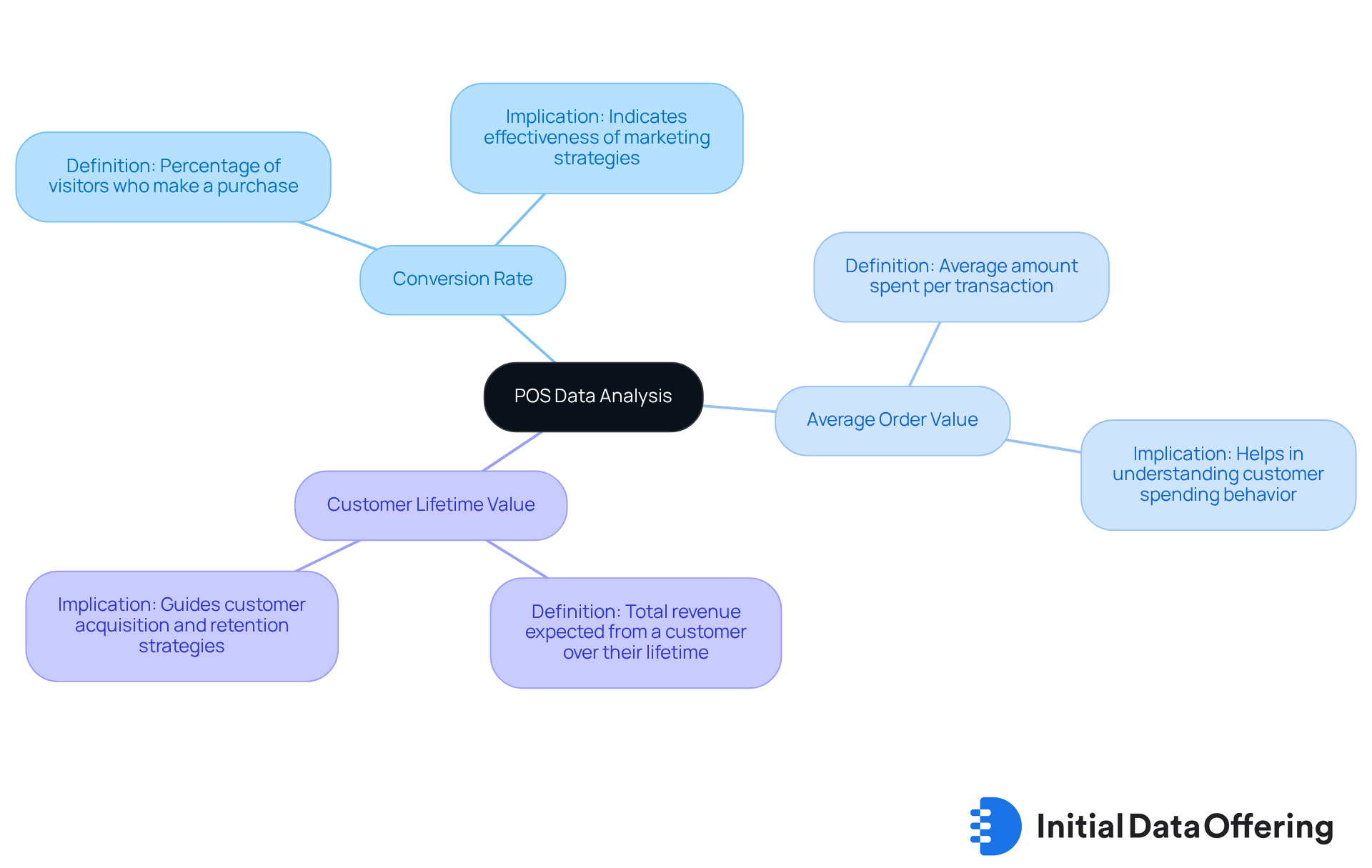
Epos Now: Practical Guides for Analyzing POS Data
Epos Now provides comprehensive guides designed to assist retailers in effectively performing POS data analysis on their information. These resources delve into essential areas such as information collection methods, key performance indicators (KPIs), and visualization techniques. A crucial initial step in information analysis involves formulating a clear hypothesis, which helps focus the examination on specific questions or objectives. By utilizing these guides, retailers can adopt a systematic approach to POS data analysis, enabling them to extract valuable insights that enhance business performance.
Industry experts emphasize the significance of KPIs in understanding client behavior and improving operational efficiency. Metrics such as:
- Retention Rate (CRR)
- Average Transaction Value (ATV)
- Conversion Rate
- Sales per Square Foot
play a pivotal role in assessing client loyalty, spending patterns, and overall store performance. Successful retailers leverage these KPIs to inform strategic decisions, ensuring they remain competitive in a rapidly evolving market.
Moreover, the role of a POS analyst is essential in POS data analysis to examine sales trends and client behavior, providing insights that foster informed decision-making. By implementing organized practices for POS data analysis, businesses can not only monitor performance but also pinpoint actionable insights, such as restocking popular items or adjusting staffing for peak hours. This ultimately drives profitability and enhances customer satisfaction.
Contextual factors such as seasonality and market trends must also be considered when analyzing POS information to derive meaningful insights. How can understanding these elements improve your business strategy? By integrating these practices, retailers can ensure they are well-equipped to navigate the complexities of the market.
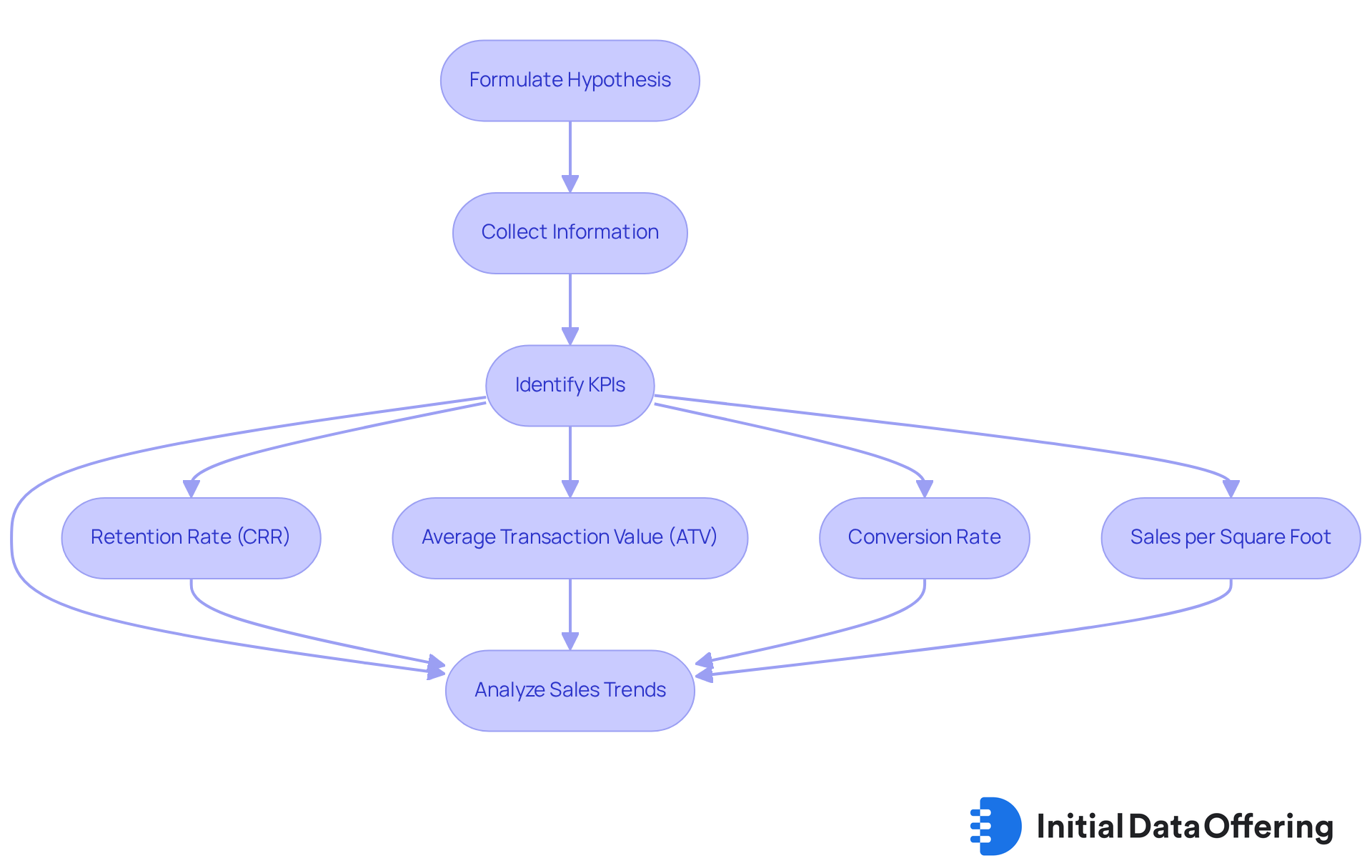
INETCO: Real-Time POS Analytics for Informed Decision-Making
INETCO specializes in POS data analysis, offering businesses immediate access to critical real-time information. This feature allows companies to monitor revenue trends, client interactions, and inventory levels as they happen. The advantage of utilizing real-time insights in POS data analysis is that retailers can make informed decisions quickly. This capability optimizes operations and enhances client experiences.
How can your business leverage these insights to improve performance? By embracing real-time analytics, including POS data analysis, businesses not only gain a competitive edge but also foster a more responsive and efficient operational environment.
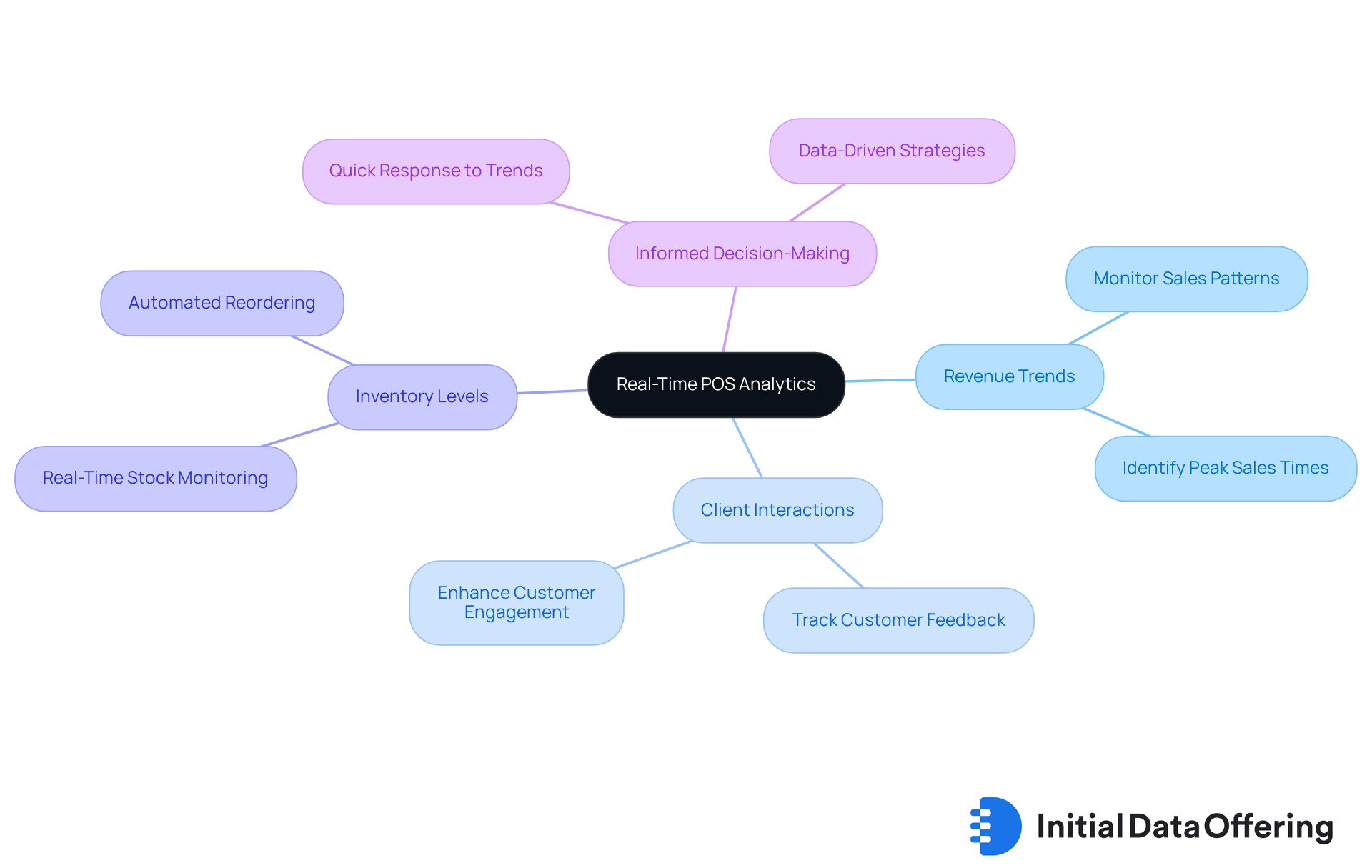
Number Analytics: Key Statistics to Drive Retail Sales Growth
Effective retail revenue growth hinges on a comprehensive understanding of key metrics such as foot traffic, revenue per square foot, and customer retention rates. Foot traffic serves as a critical measure of a store's attractiveness and marketing efficiency, often correlating directly with revenue figures. For instance, businesses may experience a substantial rise in foot traffic—up to 30%—during peak seasons or local events, which directly influences their revenue performance. However, it is essential to recognize that foot traffic patterns in the United States are on the decline due to the surge in e-commerce, posing challenges for businesses striving to maintain consumer engagement.
Using POS data analysis to analyze foot traffic data allows businesses to identify trends and refine their marketing strategies. For example, a clothing store may observe a 15% increase in foot traffic following a competitor's closure, underscoring the competitive dynamics at play. Additionally, a store situated near a newly opened subway station might experience a 40% increase in foot traffic due to enhanced accessibility, illustrating the significant impact of location on retail performance. Retailers can utilize insights gleaned from POS data analysis to enhance customer engagement, such as optimizing staffing levels during peak hours or orchestrating promotional activities that coincide with high-traffic periods.
Sales per square foot remains a pivotal metric for evaluating retail performance. A store's conversion rate, representing the percentage of visitors who make purchases, can be markedly improved through POS data analysis of foot traffic trends. For instance, a merchant achieving a conversion rate of 40% demonstrates effective marketing strategies that successfully convert foot traffic into revenue. On-Shelf Availability (OSA) is equally crucial, as it monitors product availability, ensuring that foot traffic translates into actual sales.
Industry experts emphasize the importance of these metrics: "Foot traffic trends can be a barometer for economic health," highlighting the need for businesses to adapt their strategies in response to consumer behavior. Furthermore, the Client Retention Rate (CRR) is vital for evaluating the effectiveness of retention strategies, linking foot traffic to customer loyalty and repeat business. By consistently monitoring and analyzing foot traffic and sales metrics with POS data analysis, businesses can make informed decisions that drive profitability and enhance the overall shopping experience.
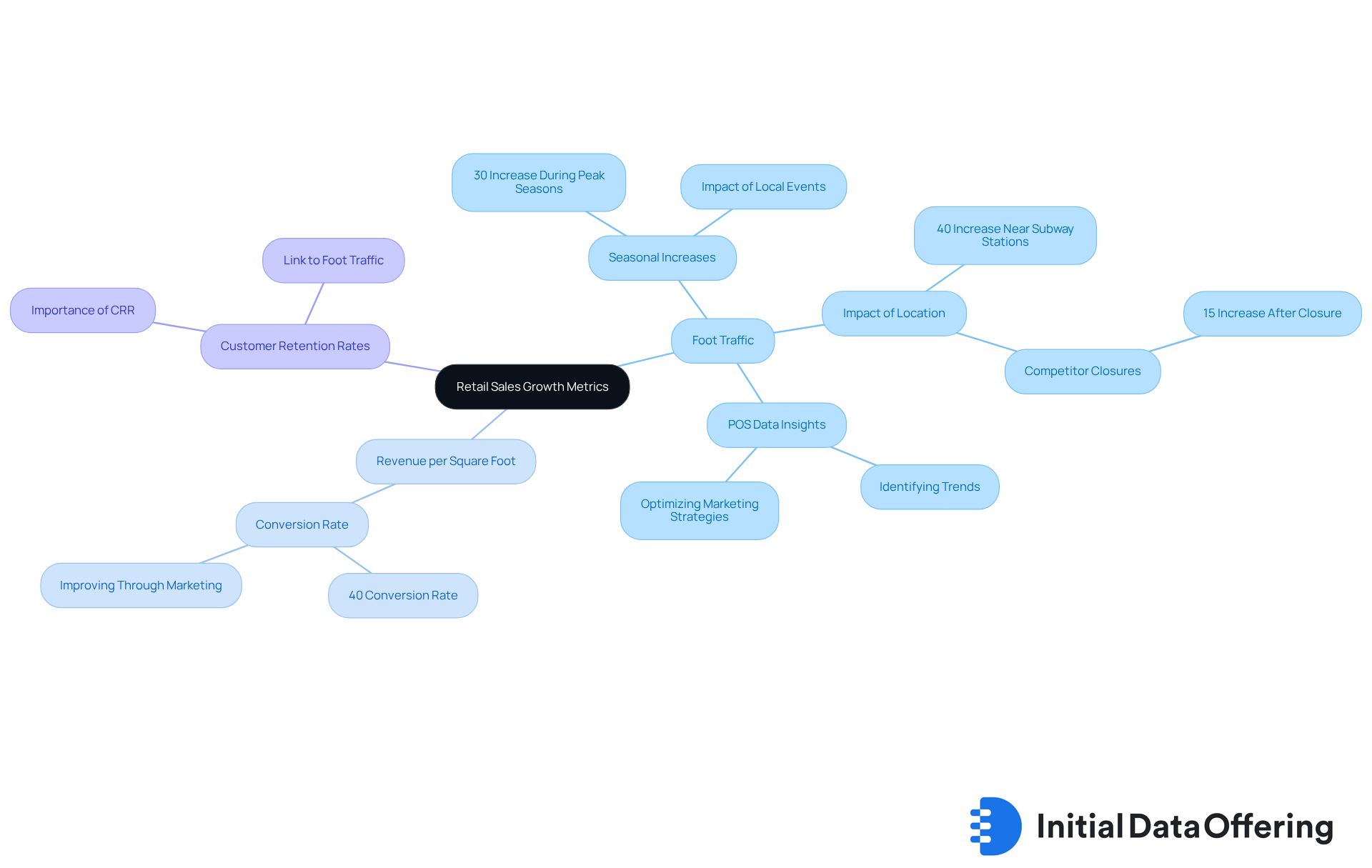
Sekure Merchants: Unlock Business Insights with POS Analytics
Sekure Merchants underscores the significance of unlocking business insights through pos data analysis. By utilizing pos data analysis on transaction data, merchants can uncover customer preferences, identify top-selling products, and refine pricing strategies. Notably, companies that prioritize information utilization, such as W3O, have reported substantial increases in turnover, showcasing the financial benefits of effectively harnessing data. These insights are vital for making informed, data-driven decisions that enhance competitiveness and stimulate growth.
Current trends indicate that retailers are increasingly focused on optimizing pricing strategies using pos data analysis for analytical insights. Industry leaders, including Andrew McAfee, assert that pos data analysis of transaction data is crucial for tailoring pricing to meet client expectations and market demands. This approach not only boosts client satisfaction but also maximizes revenue potential, demonstrating the dual benefits of informed pricing strategies.
Numerous examples illustrate how businesses successfully discern client preferences through pos data analysis. For instance, retailers can monitor purchasing patterns to ascertain which products resonate most with their clientele, facilitating targeted marketing and efficient inventory management. Moreover, analyzing customer movement, as evidenced in the Journey Tracking case study, supports the optimization of staffing and engagement strategies, ultimately enhancing sales performance.
In conclusion, the importance of pos data analysis for transaction information cannot be overstated. It empowers merchants to make informed decisions that align with customer needs, refine pricing strategies, and identify high-performing products. This fosters a data-driven culture that not only supports sustained growth but also drives innovation.
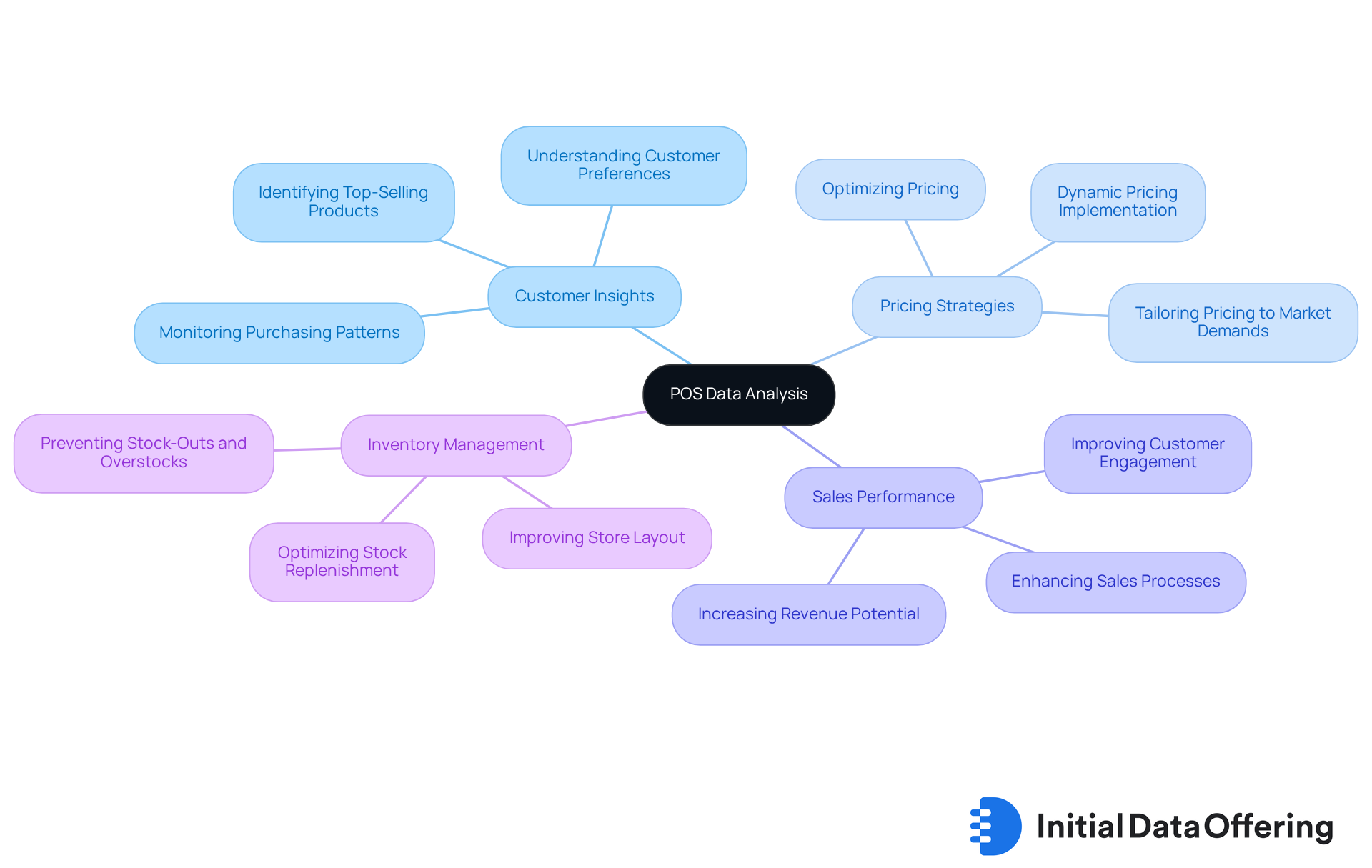
Shopify: Tools for Effective POS Data Analysis
Shopify offers a comprehensive suite of tools designed for effective POS data analysis, prominently including dashboards that aid in visualizing transaction data. These dashboards enable retailers to monitor performance metrics in real-time, which supports swift decision-making based on POS data analysis and actionable insights. The available reporting capabilities, which include POS data analysis, allow for thorough performance monitoring, covering essential aspects such as revenue trends, customer behavior, and inventory management, all vital for refining retail strategies. Accurate information gathering is paramount for effective decision-making, as it directly influences the insights derived from these dashboards.
Dashboards enhance the visualization of sales information by transforming complex datasets into accessible graphical displays, which empower businesses to identify patterns and trends with greater ease. For instance, companies can depict revenue performance across different locations or product categories, leading to targeted marketing strategies and necessary inventory adjustments. The importance of precise data is underscored by the analogy to the U.S. Census, which aims to ensure equitable resource distribution through accurate counts; similarly, businesses must guarantee the accuracy of their revenue data to allocate resources effectively.
Numerous successful examples illustrate how businesses leverage Shopify's dashboard capabilities to stimulate growth. A clothing retailer, for example, implemented a dashboard to monitor revenue performance by demographic, resulting in a 20% improvement in targeted marketing efficiency. Another case involves a food and beverage company that utilized sales information visualization to optimize product placement, achieving a 15% increase in sales during peak hours. These instances underscore the transformative impact of effective information visualization in retail analytics. As noted by industry experts, 'Information-driven report cards offer a visually rich and easy-to-understand presentation of test outcomes for both patients and physicians,' highlighting the broader applicability of visualization tools across various sectors, including retail.
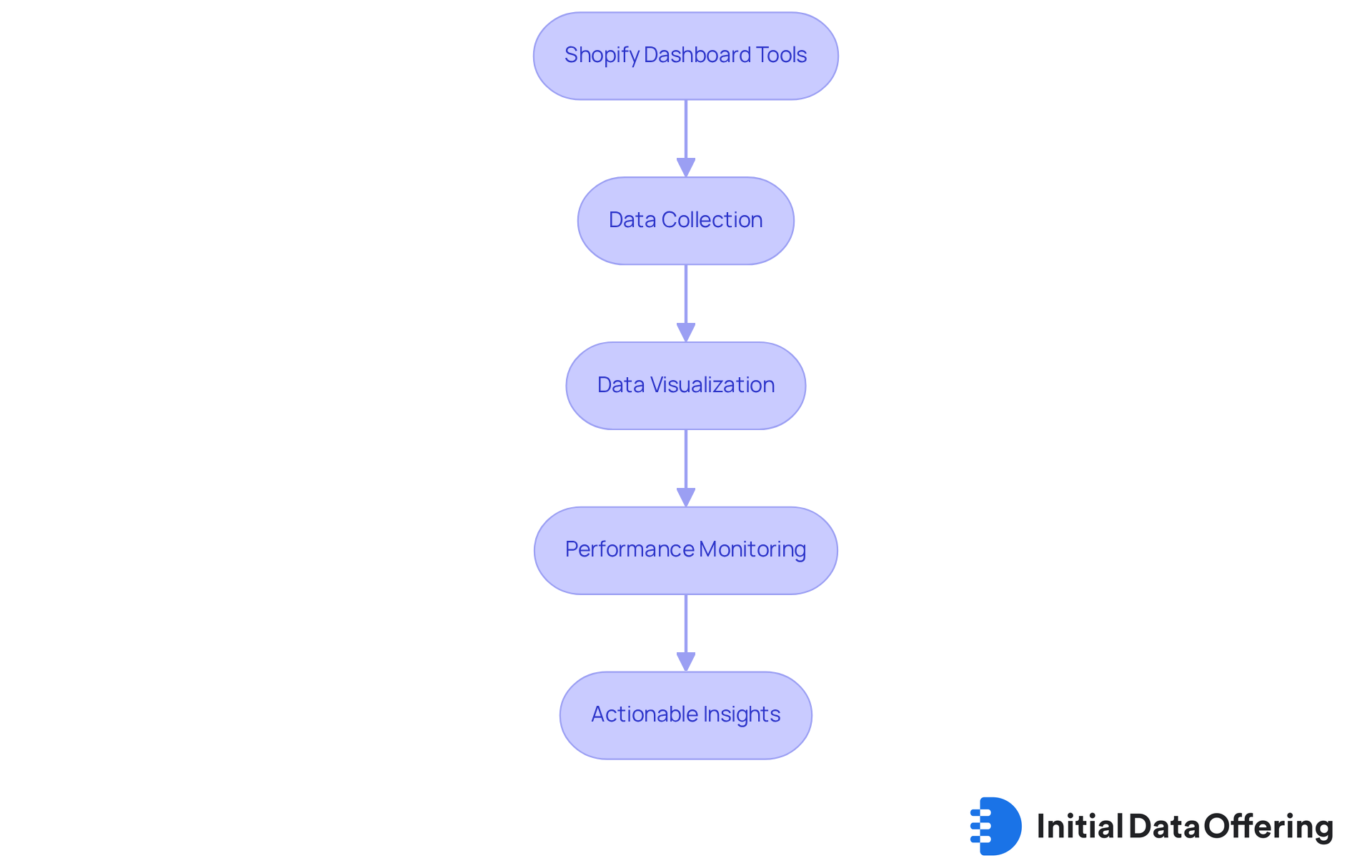
Krunchbox: Solutions for Common POS Data Challenges
Ensuring information accuracy is paramount in retail analytics, as it directly influences decision-making and operational efficiency. Retailers like Cafe Gratitude have successfully enhanced their information precision and accessibility by adopting advanced POS systems, which streamline order-taking and improve communication. For instance, Cafe Gratitude, using Toast, reduced their average order-taking time from 20 minutes to just 3 minutes per table. This shift not only reduces order times but also allows for better inventory management and customer engagement.
Present trends show an increasing dependence on integration solutions that enable smooth connectivity between different retail systems. By 2025, 72% of retailers are anticipated to adopt cloud-based POS systems, allowing real-time updates and centralized information management. Such integration is crucial for maintaining accurate inventory levels and enhancing customer experiences, ultimately leading to improved operational efficiency.
Industry specialists highlight the significance of tackling quality concerns. According to Robert Johnson, a retail analytics specialist at Deloitte, "POS information represents the most direct and precise reflection of what’s actually occurring at the moment of purchase decision—making it arguably the most valuable collection retailers possess." Retailers that leverage advanced POS data analysis experience, on average, 30% higher revenue growth compared to competitors who do not prioritize such analysis. Strategies for enhancing accuracy involve adopting structured frameworks for information validation and investing in thorough staff training, which can result in a 64% rise in the uptake of advanced POS features.
Moreover, a systematic method for POS integration can lead to 40% fewer interruptions, further improving information precision and operational effectiveness. By focusing on these solutions, businesses can transform their data management processes, enabling them to concentrate on POS data analysis rather than simply managing data. This shift ultimately leads to actionable insights and better business outcomes.
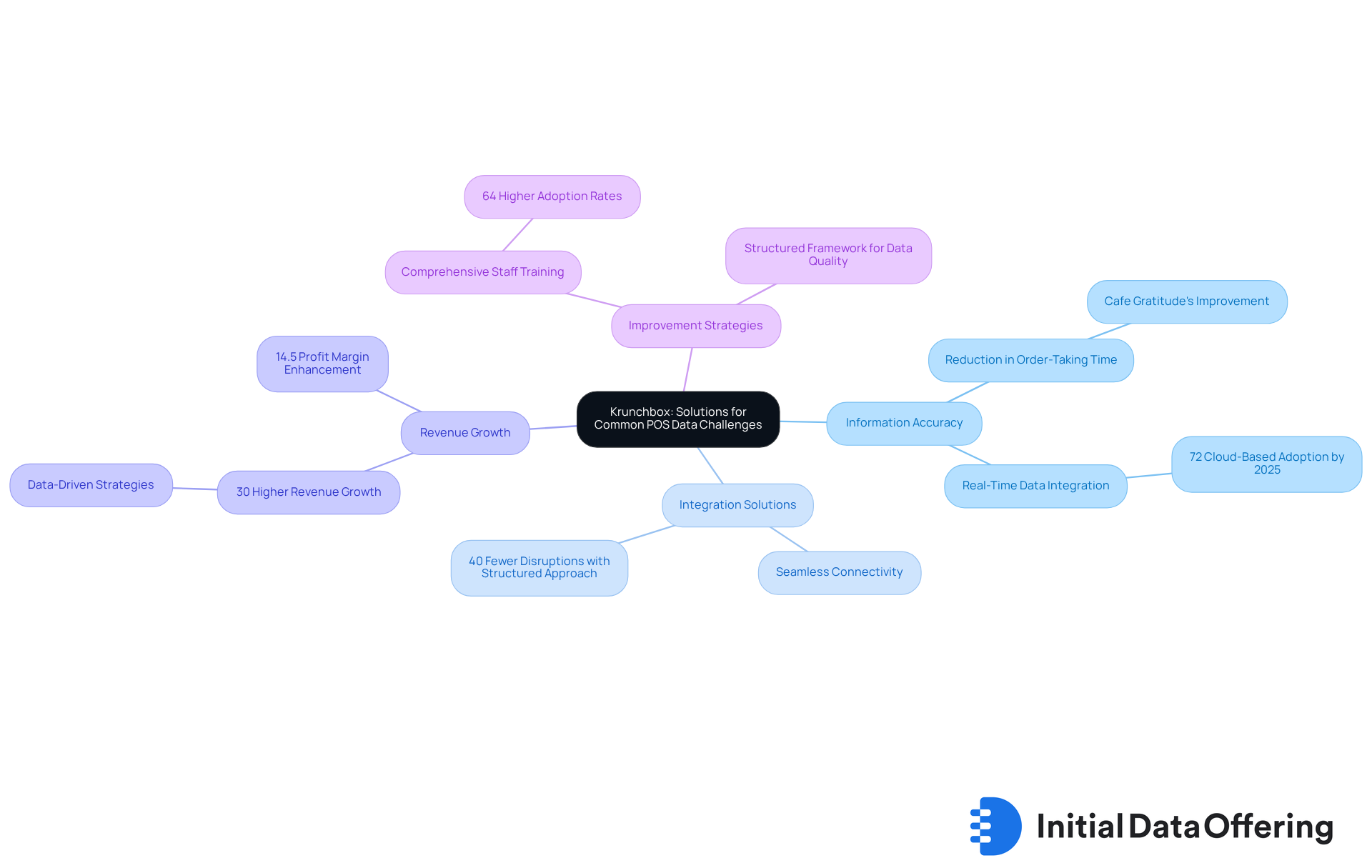
Solink: Advanced POS Monitoring for Fraud Prevention
Advanced POS monitoring solutions serve as a critical feature for effective fraud prevention in retail. By leveraging POS data analysis, retailers can swiftly identify suspicious activities, gaining a significant advantage. This proactive strategy not only mitigates risks but also fosters client trust and loyalty—essential benefits for sustained success.
For instance, the retail sector has experienced a staggering 183% increase in suspected fraud attempts, underscoring the urgent need for robust monitoring systems. Furthermore, organizations that implement regular security training have reported an 84% reduction in susceptibility to phishing attacks, demonstrating how such training enhances overall fraud detection capabilities.
As noted by a security analyst, 'POS data analysis and real-time transaction analysis are essential for staying ahead of evolving fraud tactics.' Moreover, with e-commerce fraud detection expected to represent 40% of the overall fraud detection market by 2025, companies that adopt advanced POS data analysis will be better equipped to protect their assets and maintain client trust.
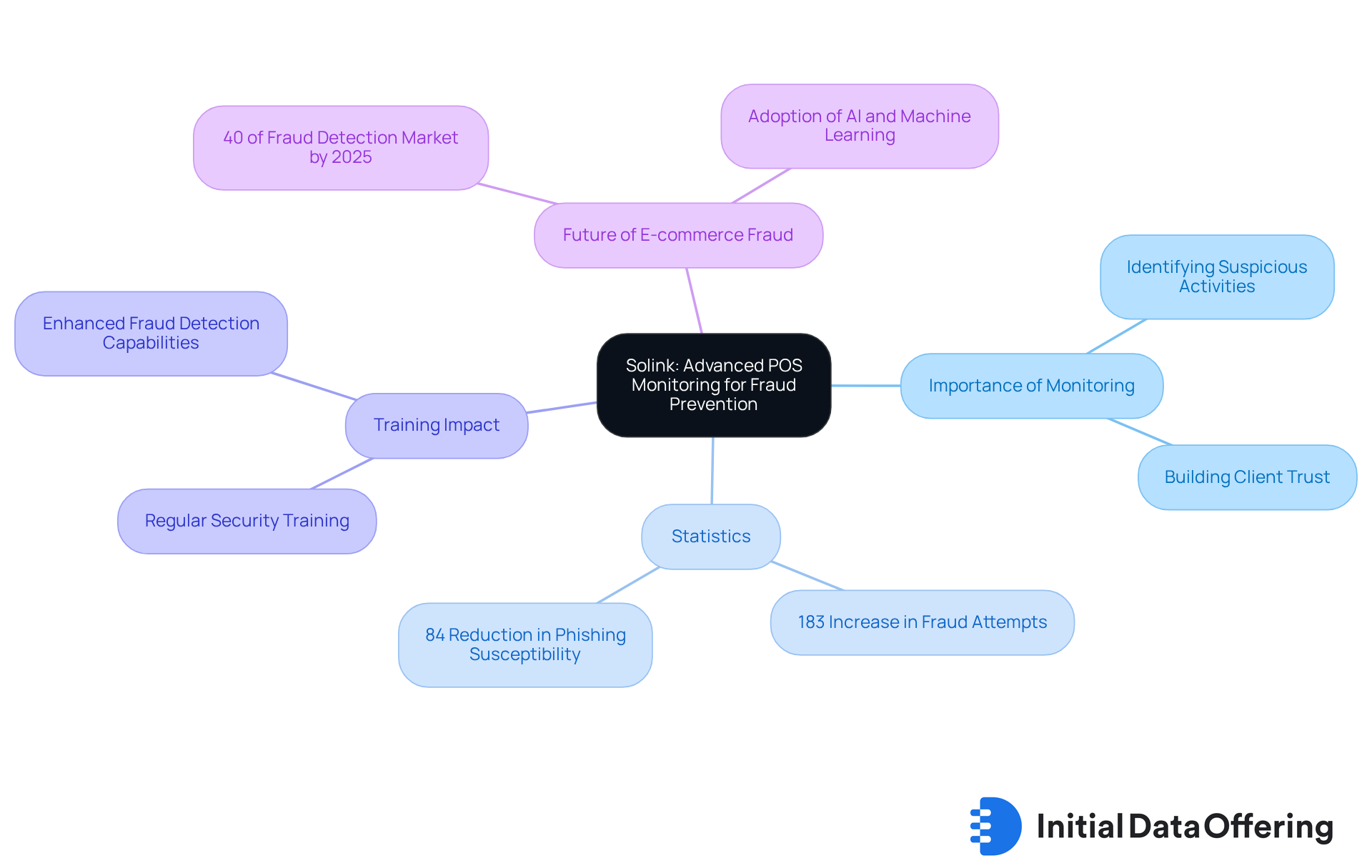
Leveraging POS Data Insights: A Competitive Advantage for Retailers
Utilizing pos data analysis provides businesses with a significant competitive advantage. By leveraging pos data analysis to understand consumer behavior, market trends, and operational efficiencies, businesses can tailor their strategies to meet market demands. This data-driven approach, utilizing pos data analysis, enables retailers to stay ahead of the competition, optimize their offerings, and enhance customer satisfaction.
For instance, Coty, which has over 10,000 employees, has successfully transitioned to evidence-based strategies through its partnership with Revuze. As Nithya Seshachalam from Coty states, "With Revuze, we’ve moved from assumptions to evidence. The information reveals not only what’s trending, but also why and what actions to take regarding it."
This democratization of insights empowers all departments to access and act on data quickly, fostering a culture of informed decision-making. By embracing these insights, retailers can navigate the complexities of the market and drive sustainable success.
How can your organization leverage such insights to enhance its strategies? The implications are clear: informed decision-making leads to a more agile and responsive business model.
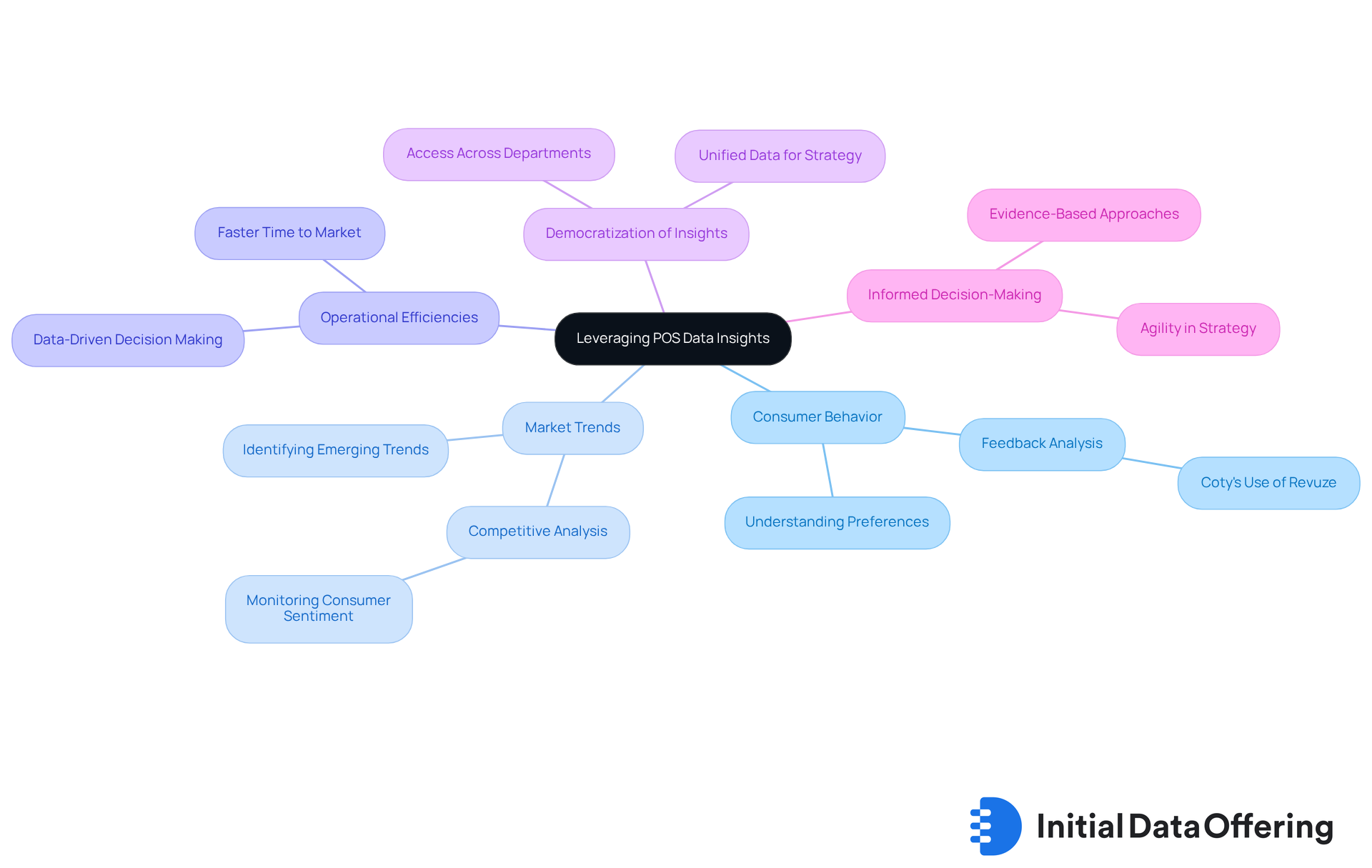
Conclusion
Utilizing effective POS data analysis is essential for retailers aiming to thrive in an increasingly competitive marketplace. By embracing diverse datasets and advanced analytical tools, businesses can unlock valuable insights that enhance decision-making, optimize inventory, and tailor marketing strategies to consumer preferences. The integration of real-time analytics, key performance indicators, and a thorough understanding of industry terminology equips retailers to navigate challenges and capitalize on opportunities for growth.
Throughout the article, key insights have been highlighted, including:
- The importance of the Initial Data Offering for accessing diverse datasets
- The role of comprehensive glossaries in understanding POS terminology
- The strategic advantages of real-time analytics
The emphasis on key metrics such as foot traffic and customer retention rates illustrates how data-driven strategies lead to improved operational efficiency and profitability. Furthermore, the discussion on fraud prevention underscores the necessity of robust monitoring systems to safeguard business assets and maintain customer trust.
The significance of leveraging POS data insights cannot be overstated. Retailers that prioritize data-informed decision-making are better positioned to adapt to market dynamics and enhance customer satisfaction. As the landscape of retail continues to evolve, businesses are encouraged to explore innovative approaches to POS data analysis, ensuring they remain agile and competitive. By taking action now to harness these insights, organizations can foster a culture of informed decision-making that drives sustainable success in the retail sector.
Frequently Asked Questions
What is the Initial Data Offering (IDO) and how does it benefit merchants?
The Initial Data Offering (IDO) provides merchants access to diverse datasets, including alternative and ESG data, which enhances their POS data analysis capabilities. It helps businesses uncover insights into consumer behavior, market trends, and operational efficiencies, ultimately driving sales growth and improving customer satisfaction.
How does using advanced POS analytics impact inventory turnover and revenue growth?
Businesses utilizing advanced POS analytics achieve inventory turnover rates that are 35% faster than those using traditional methods. Additionally, retailers leveraging POS data analysis can experience up to a 30% increase in revenue growth, highlighting the transformative potential of data-informed decision-making.
What role does alternative information play in retail insights?
Alternative information is crucial for shaping retail insights, as it provides quantitative data necessary for strategic planning. Industry leaders emphasize its importance, and the market for alternative information is projected to reach USD 135.72 billion by 2030, indicating its growing influence on retail analytics.
How can retailers enhance their analytical capabilities using IDO's datasets?
By utilizing IDO's diverse datasets for POS data analysis, retailers can significantly improve their analytical capabilities, leading to better decision-making, optimized inventory management, and customized marketing strategies that drive growth and operational efficiencies.
What resources does BigCommerce provide for understanding POS data analysis?
BigCommerce offers a comprehensive glossary that includes key terms such as conversion rate, average order value, and customer lifetime value. Understanding these terms is essential for accurately interpreting data and making informed business decisions.
What guides does Epos Now provide for analyzing POS data?
Epos Now provides practical guides that cover information collection methods, key performance indicators (KPIs), and visualization techniques. These resources help retailers adopt a systematic approach to POS data analysis, enabling them to extract valuable insights that enhance business performance.
What key performance indicators (KPIs) should retailers focus on for effective POS data analysis?
Retailers should focus on KPIs such as Retention Rate (CRR), Average Transaction Value (ATV), Conversion Rate, and Sales per Square Foot. These metrics are essential for understanding client behavior, loyalty, and overall store performance.
What is the significance of a POS analyst in data analysis?
A POS analyst plays a vital role in examining sales trends and client behavior, providing insights that support informed decision-making. They help businesses monitor performance and identify actionable insights, contributing to profitability and customer satisfaction.
What contextual factors should be considered when analyzing POS information?
Contextual factors such as seasonality and market trends are important to consider when analyzing POS data. Understanding these elements can lead to more meaningful insights and improved business strategies.